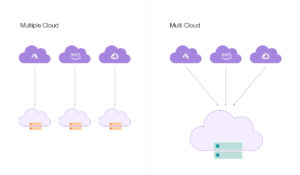How Important Is It For Your Cloud To Be Resilient?
 By Anita Srinivasan
By Anita Srinivasan
 21st September, 2023
21st September, 2023
Cloud Computing Services
Cloud DevOps Practices
Cloud-native Applications
Cloud Cost Optimization
Businesses today are competing to make the most out of the $3 trillion opportunity that Cloud-based platforms present in EBITDA.
A crucial factor to consider when moving to the cloud is the resilience of applications, as the maximum of the cloud value lies in running business-critical operations.
Cloud provides a stable on-premises environment with faster recovery time, more compliance and upgraded tools that provide optimal resiliency capabilities. Companies must design, architect, and adopt appropriate resiliency patterns to meet their specific requirements and to leverage these cloud capabilities.
Cloud resiliency patterns are targeted towards reducing technical debt, automating operations, and equipping applications with cloud capabilities.
Understanding Cloud Resiliency
Cloud resiliency is the capability of cloud infrastructure to maintain high availability, reliability, and fault tolerance even during unexpected disruptions such as hardware failures, network issues, or natural disasters. It is the backbone of an organization’s digital operations, ensuring that critical services and data remain accessible at all times.
Amid rapidly evolving customer expectations and regulatory demands, leaders and industry professionals have expressed genuine concerns over ensuring that their critical applications are always functioning and available.
The reason that few companies have moved their critical applications to the cloud can revolve around these concerns. A survey of leaders and technology experts revealed that only 10% successfully moved their critical and mission-based processes to the cloud.
Want to move to the cloud? Download our exclusive Cloud Migration White paper for detailed insights.
Cloud-related issues can be tackled by conducting two crucial analyses:
The first analysis can help determine the financial and reputational impact on the business. Organizations often tend to underestimate or overestimate these costs, which leads to inconsistencies in the decision-making process.
The second analysis helps businesses determine the on-premises operations-related costs compared to the cloud-related expenses. Cloud-based solutions are often more cost-effective and flexible, which allows them to accommodate usage surges and their pay-as-you-go model.
To derive cost benefits, leaders must ensure that their applications are designed well, their infrastructure is well developed and configured, and the lifecycle of the existing hardware is also considered.
Organizations can avoid expensive capital investments and hardware-related costs by migrating critical operations into the cloud, especially before any major changes in their hardware structures. Strong Fin Ops capabilities are required to acquire and build on these insights.
Why Is Cloud Resiliency Important?
Cloud resiliency is fundamental for business continuity. Downtime can lead to significant financial losses, damage to reputation, and customer dissatisfaction. Cloud services minimize downtime, helping businesses stay operational in all circumstances.
According to a survey conducted by Gartner, organizations that rely on cloud technology for over 75% of their backup and recovery requirements can expect to reduce their overall cost of business continuity and disaster recovery by 60%. ( 3)
The cloud allows businesses to scale their resources up or down as needed. A resilient cloud infrastructure ensures that this scaling happens seamlessly, enabling organizations to meet sudden increases in demand without service interruptions. According to a Forbes survey, since 2020, 83% of companies have been managing their workloads in the cloud. (2)
In the event of a disaster or a hardware failure, cloud resiliency plays a crucial role in disaster recovery. Data replication, backup, and redundancy strategies implemented by cloud providers help safeguard data and applications, allowing for quick recovery. A survey by the Disaster Recovery Journal found that 46% of organizations using the cloud for disaster recovery reported faster recovery times. (4 )
Security is a significant aspect of resiliency. Cloud providers invest heavily in cybersecurity measures, protecting against cyber threats and data breaches. It enhances the overall resiliency of cloud-based systems.
- Cost-Efficiency:
Building a resilient on-premises infrastructure can be expensive and complicated. In contrast, cloud resiliency is usually more cost-effective. Cloud providers manage the complexities of redundancy, failover, and disaster recovery, enabling businesses to concentrate on their primary operations without the stress of extensive infrastructure management.
Companies that can provide uninterrupted services have a competitive advantage. Clients value reliability and are more likely to choose firms that can guarantee their services will be available when needed.
Forbes reported that 74% of Tech Chief Financial Officers (CFOs) believe cloud computing has the most measurable impact on their business. (5)
Resilient Cloud infrastructures can adapt to changing business needs. They enable organizations to expand their digital footprint and implement new technologies without disruptions.
How Can Cloud Providers Help With Resiliency?
Cloud providers deploy redundant hardware and network frameworks across multiple data centres. When one data centre experiences an issue, traffic can be accordingly rerouted to another, minimizing disruptions.
Cloud providers often replicate data across multiple geographic regions. It ensures data availability even if a specific area faces a disaster or outage.
Load balancing distributes incoming traffic across multiple servers, preventing overloads on any single server and ensuring high availability and performance.
Cloud services are architected with automatic failover mechanisms. If a server or data centre experiences a failure, services are automatically shifted to a healthy one, reducing downtime.
Cloud providers regularly monitor their infrastructure and services. They use advanced monitoring tools and artificial intelligence to detect issues and send alerts to administrators.
Critical Steps To Take Towards Cloud Resiliency
To launch cloud resiliency, companies must be aware of potential risks and equip themselves with the required resources to mitigate them.
Here are five critical steps to adopt cloud resiliency:
- The first step is prioritizing urgent business operations, identifying all related applications, and aligning the organization’s strategic goals with the impact analysis results.
- The second step is to identify the pain points and technical hindrances organizations encounter during cloud migration. In addition to this, companies must also define resiliency patterns to meet specific business needs.
- Companies must design a roadmap to implement a trial lighthouse to accelerate the learning process and add value.
- Organizations must also identify gaps in processes (such as incident, problem, and change management) and talent (including unfilled engineering roles) in conjunction with the architecture.
- The last step should be setting achievable goals for making the cloud resilient and ensuring that it aligns with business goals, duration, and costs.
Cloud resiliency is vital for ensuring the availability, reliability, and security of digital services in an increasingly interconnected world. It not only safeguards businesses against disruptions but also enables them to thrive, innovate, and remain competitive in a rapidly evolving digital landscape.
Consequently, it is a key consideration for organizations when selecting cloud providers and designing their cloud-based solutions. Businesses that harness the power of the cloud’s resiliency are better prepared to deal with disruptions and continue delivering their services without hindrances.
For more insights on Cloud Migration and Top Trends in the Cloud, please refer to our informational video on Top Cloud Native Trends to Watch in 2023.
References:
- McKinsey
- 83% Of Enterprise Workloads Will Be In The Cloud By 2020. (Forbes)
- Source: Gartner
- Source: Disaster Recovery Journal
- Roundup Of Cloud Computing Forecasts, 2017. (Forbes)






























